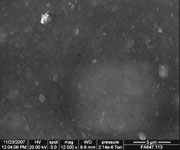| Jia, et. al., describe the co-electrodeposition of an adherent CNT composite coating with enhanced mechanical properties transferred to a macrostructure. This is, perhaps, the first time a significant enhancement in the intrinsic strength of a macrostructure has been reported for an additive coating incorporating cross-linked nanocomposites. |
Reviewed by Jeff Morse, Ph.D., National Nanomanufacturing Network
- Jia FL, Gong JM, Wong KW, and Du RX. 2009. Simple co-electrodeposition of functionalized multi-walled carbon nanotubes/chitosan composite coating on mainspring for enhanced modulus of elasticity. Nanotechnology 20(1) 015701. DOI: 10.1088/0957-4484/20/1/015701

Recent work published in Nanotechnology describes the co-electrodeposition of functionalized multi-wall carbon nanotubes (f-MWCNTs) with chitosan, a functional and basic polysaccharide bio-polymer (Jia et al. 2009). While research has demonstrated that chitosan interacts with CNTs forming stable dispersions, and composite materials can be formed with improved mechanical strength, the authors report for the first time an adherent CNT composite coating with enhanced mechanical properties transferred to a macrostructure.
In this work, the authors coated stainless steel mainspring structures with a CNT-chitosan composite. They exploited the extensive cross-linkage formed between carboxyl (-COOH) groups on the f-MWCNTs and hydroxyl (-OH) amino (-NH2) groups in the chitosan. Purified MWCNTs were functionalized by chemical treatment in 65% nitric acid at 140°C for 3 hours, resulting in the carboxyl functional groups on the outer surface. The authors then formed the electrolyte suspension by combining and mixing the well-dispersed solutions prepared containing the f-MWCNTs and chitosan respectively. The authors found that f-MWCNTs could be readily co-electrodeposited onto the surface of the mainspring in the presence of chitosan. Furthermore, the molecular chains of the chitosan and the f-MWCNT chemically react with each other forming physical knots, which leads to a three-dimensional, interlaced composite coating. The thickness of the coating could be controlled from a few hundred nanometers to several microns. The authors report that the coating adhesion was so strong it could only be removed by physically scraping the coating from the stainless steel.
By exploiting the strong cross-linking between a functionalized nanostructure and subsequent bio-polymer material, a novel composite was studied having high mechanical strength. For an 8-micron-thick composite coating electrodeposited onto a 120-micron-thick stainless steel mainspring macrostructure, an increase in Young’s modulus of 25% was measured. This is, perhaps, the first time a significant enhancement in the intrinsic strength of a macrostructure has been reported for an additive coating incorporating cross-linked nanocomposites. Electrodeposition offers a simple method for forming stable, reproducible, and rigid composite coatings. Further investigations may consider extending the functional groups and chemistries in order to broaden the range of material compositions that can be coated by this technique.
Image reproduced from Jia FL, Gong JM, Wong KW, and Du RX. 2009. Simple co-electrodeposition of functionalized multi-walled carbon nanotubes/chitosan composite coating on mainspring for enhanced modulus of elasticity. Nanotechnology 20(1) 015701. Permission pending.
This work is licensed under a Creative Commons Attribution-NonCommercial-NoDerivs 3.0 Unported.
